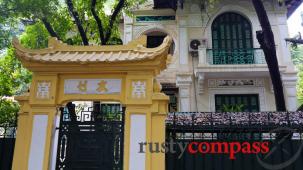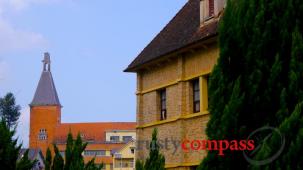Trang Tien Bridge on the Perfume River is where our 3 day Hue journey begins - right in the centre of town. The bridge dates back to French times and was badly damaged during the Tet Offensive in 1968. It wasn't repaired until the early 1990s.
Stunning Thien Mu Pagoda on the Perfume River is a great place to start the day. Rise early to see Thien Mu at its atmospheric best.
- Thien Mu Pagoda is a Hue icon and predates the Nguyen Dynasty.
- Thien Mu has also been a hotbed of Buddhist activism in Vietnam and played a crucial role in the Buddhist uprising of 1963 that led to the assassination of President Ngo Dinh Diem. At the back of the pagoda sits the Austin that Monk Thich Quang Duc drove before his self immolation at a busy Saigon intersection in June 1963. Malcolm Browne's haunting photograph is behind the car.
- Heading back along the river towards the citadel, it's worth stopping in at one of the beautiful traditional garden homes.
- The Citadel is Hue's signature attraction - the former home of Hue's blighted last dynasty. The French started harassing the Nguyen dynasty not long after its founding at the beginning of the 19th century. During the Tet Offensive in 1968, the Viet Cong flag flew from this tower for three weeks before US and South Vietnamese forces reclaimed it.
- Hue citadel. By the end of the 19th century, the French had total control of Vietnam. The Nguyen kings were figureheads only. It was here at Ngo Mon Gate that Vietnam's last Emperor Bai Dai abdicated in favour of Ho Chi Minh's Communists in 1945. 23 years later in 1968's Tet Offensive, the citadel was severely damaged by US aerial bombing and ground fighting against communist forces.
- The Citadel walls are severely scarred from war.
- Hue's Miltary Museum doesn't shed much light on the city's tragic war history but it's definitely worth passing by.
- An Dinh Palace was one of Emperor Khai Dinh's residences. Bao Dai lived here after his abdication in 1945 before moving to France. Like much of Hue's heritage, it was left to ruin after the communist takeover and was only recently restored. The Royal Fine Arts Museum is now located in a small building on these grounds.
- Royal Fine Arts Museum, Hue
- One of Hue's most extraordinary historic sights is the Tu Cung Residence where Bao Dai's mother resided until her death after the communist takeover in 1975. I have never seen another tourist here - but more than anywhere else, it is in this place, decorated with family photos and heirlooms, that the very human end of the Nguyen dynasty is most poignantly exhibited.
- Three generations of a Hue family in the backstreets behind the citadel wall.
- People of the backstreets inside the citadel walls Hue.
Bach Dang St Hue
- Banh Beo is a Hue specialty. You can enjoy some very local banh beo at Ba Do's restaurant in Chi Lang area not for from Bach Dang St.
- Selling pomelo at Hue's Dong Ba Market
Dong Ba Market. This old South Vietnamese Army veteran has been a cyclo driver for most of the time since the end of the war in 1975. There were no other opportunities for these men in communist Vietnam. Things have improved but there are still many former ARVN soldiers driving cyclos in Hue despite their advancing years.
- On day 2 of our journey we live Hue's town and head into the surrounding countryside to visit historic tombs and pagodas. The cycling is easy and there's some beautiful countryside as well.
- First stop is Minh Mang's Tomb - a classic Confucian structure, its buildings are set sparsely amidst lovely ponds and gardens.
Khai Dinh's Tomb - the last Nguyen Dynasty tomb is more bizarre than beautiful - but a must see anyway!
- Tu Duc's Tomb along with Minh Mang's are considered the most architecturally significant of the tombs.
- Not far from Tu Duc's Tomb is Tu Hieu Pagoda. At one time the eunuch's pagoda, Tu Hieu's recent fame is on account of its famous alumni, Thich Nhat Hanh, one of international Buddhism's most celebrated voices. It's a beautiful peaceful space.
Cycling in the Hue countryside. A heavy load - this woman has a motorcycle on the back of her bicycle!
- Most of the country roads around Hue are quiet and relatively safe for cycling.
- The dilapidated Ho Quyen was the Royal Arena for Nguyen Dynasty Emperors.
- Nearby Long Chau Dien Temple is a wonderful ruin the likes of which are becoming more difficult to find in Hue as local officials seem hellbent on making the historic city feel more like a Disney exhibit.
- National School. Uncle Ho, General Giap and Ngo Dinh Diem all studied here.
Hue's National School. A statue of star graduate Ho Chi Minh is flanked by the hammer and sickle and the Vietnamese national flag.
Hue's unique melancholy atmosphere is the stuff of Vietnamese legend - and the Perfume River plays its part in creating that feel.
The deco La Residence Hotel is a good place for a riverside cocktail. Once a government guesthouse, the dramatic capture of the building and kidnapping of a senior South Vietnamese official by communist forces in the Tet Offensive is powerfully recounted in the book Where the Ashes Are by Nguyen Duc Quy.
- Enroute to Thanh Toan covered bridge.
- Hue city limits - en route to Thanh Toan covered bridge.
- Thanh Toan covered bridge, Hue
- Thuan An Beach, Hue
Cycling through the Hue countryside to Gia Long's tomb.
- The boat ride to Gia Long's Tomb - the oldest and furthest from the city.
- Gia Long, the first Nguyen Dynasty emperor's tomb sits in a lonely and infrequently visited spot 16km from Hue.
FOR MORE DETAIL ON THIS ITINERARY, CHECK -
http://rustycompass.com/destinations/category/city_8-vietnam-hue/18-our-ideas/47-72-hours


















































